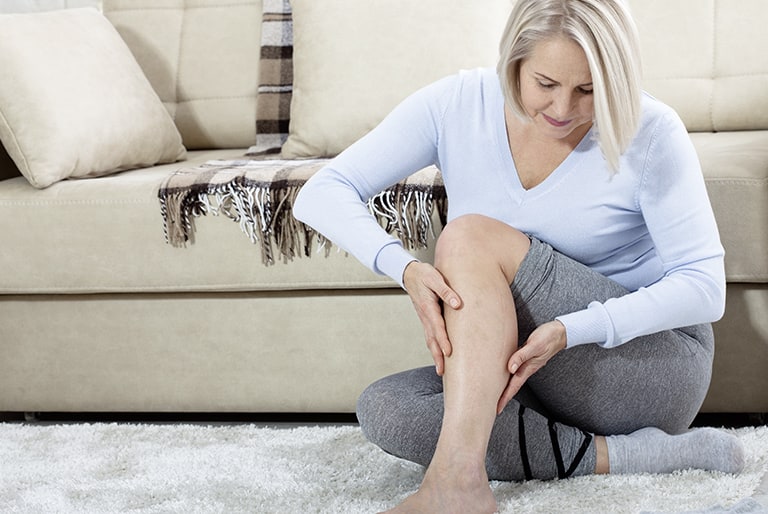Do varicose veins increase the risk of thrombosis?
With varicose veins there is a backlog of blood in the veins in your legs, which is then visible through the surface of the skin as a result of them typically protruding. But is it true that varicose veins also increase the risk of thrombosis and why is that?

Why can varicose veins increase the risk of thrombosis?
Varicose veins (varices) are the result of chronic venous insufficiency. That means that your veins cannot remove the oxygen-poor blood sustainably upwards towards your heart. If such venous insufficiency exists, your blood vessels become increasingly damaged over time, and they expand because blood increasingly collects in your leg veins.
On the one hand, that is because the muscle pump does not actively help your veins with the pumping due to a lack of movement, and on the other, the venous valves do not close sufficiently in expanded blood vessels and let the blood which has been moved upwards fall back down again. This backlog of blood in your legs then becomes visible in the form of varicose veins – in the first instance a cosmetic flaw.
The backlog of blood also encourages the formation of blood clots. If your blood flow falters, a blood plug, also called a thrombus, can form in your leg vein and block the blood vessel. If your legs are inflamed by the varicose veins, there is also an increased risk of thrombosis.Vein thrombosis can go unnoticed in your superficial veins, but if the blood clot forms in a deep leg vein it is life-threatening. Because if the thrombus detaches and is transported through the bloodstream to your lungs, it can lead to pulmonary embolism, which is considered to be an absolute emergency.
Do varicose veins really increase the risk of thrombosis?
But there are other factors which encourage thrombosis:
- Operations
- Inactivity
- Excess weight
- Prolonged sitting on journeys, e.g. on a plane
- Long confinement to bed
- Predisposition:
- Coagulation disorder
- Smoking
- Pregnancy
- Medicines, e.g. birth control pill
You should take preventive measures if several of these factors apply, in order to support your vein function.
How can I recognise thrombosis?
Watch for the following symptoms, which usually only appear on one leg, and do not hesitate to call an ambulance because these indications point to deep vein thrombosis, which must be treated urgently:
- Leg pains, which appear suddenly or repeatedly and have no recognisable cause.
- Pain when putting your foot down
- Swollen leg
- Feeling of tightness in the skin
- Sensitivity to pressure
- Warm sensation on your leg, your skin feels unusually warm
- Bluish discolouration of the skin
Indications of pulmonary embolism are also sudden shortness of breath, heart palpitations, dizziness and pain in the chest. In this case, there is a danger to life!
Movement is the wrong first aid measure in cases of vein thrombosis, as that can cause the blood clot to detach itself. If the above-mentioned symptoms occur, keep your leg still until the doctor arrives.
It can also be that thrombosis causes no symptoms and remains totally unnoticed. Some blood clots even dissolve on their own.
How can I prevent thrombosis?
An important factor in preventing thrombosis is to keep your blood flowing. That can be ensured through various measures:
- Lots of movement and sport: while sitting and standing encourage the build-up of blood in your legs, the movement of your legs dissolves the congestion again. That is why your feet and legs should be moved regularly, preferably by walking, vein gymnastics and moderate endurance sports. The calf muscles activate the muscle pump, which transports the blood out of your veins to the heart.
- Drink enough: fluid blood flows better through your arteries and veins than thick blood does. That is why it is also so important to drink at least two litres of water or unsweetened tea every day.
- Compression therapy: the external pressure from the compression stockings prevents your vessels from expanding and your blood from collecting. Compression therapy has proven itself well in the prevention of thrombosis and is also frequently used for treating varicose veins.
- Medicines: the fluidity of your blood can be increased by special medicines. Veno SL® 300 provides additional stability to your blood vessels, so that they maintain their elasticity.
A healthy lifestyle generally has a positive effect on your vein function. People who actively support their veins from early on and who regularly exercise can prevent serious diseases and consequential damage.
1 Source: aerzteblatt.de